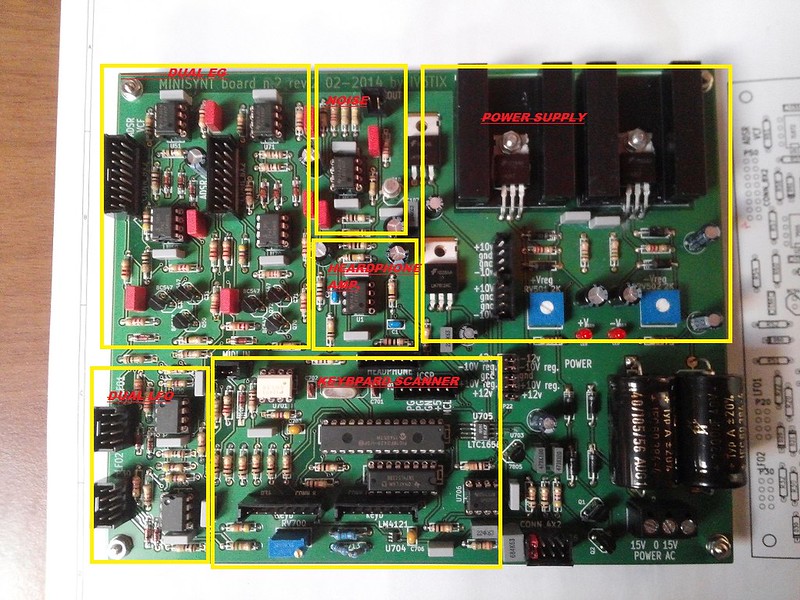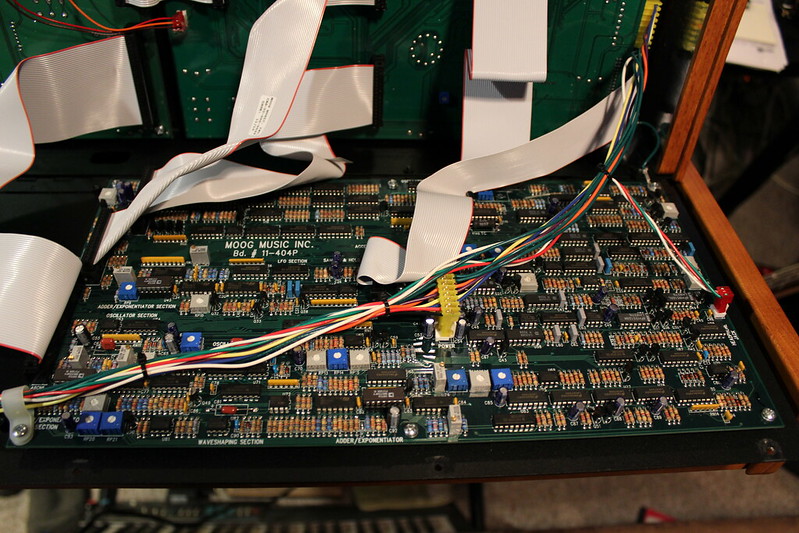Page 1 of 2
Minimoog Clone
Posted: Fri Aug 01, 2014 4:19 am
by EricK
I know some of you don't do facebook but there's a "Moog Fan Club" group and this was posted there a few minutes ago:
https://fbcdn-sphotos-d-a.akamaihd.net/ ... 7999_o.jpg
The picture is displaying too big but there it is. Has a full ASDR. If you click on the link below you can see his comments in regards to the absence of the glide switch.
https://www.facebook.com/photo.php?fbid ... =1&theater
Re: Minimoog Clone
Posted: Fri Aug 01, 2014 12:12 pm
by thealien666
Wow, great work ! Seems he took the casing of a Voyager and converted the panel to a Minimoog... Really looks like a grandchild of grandpa Mini D !
But the missing glide switch is too bad. I know he says that the glide can be turn off by the knob, but when I play my Minimoog D the fact that I can turn on and off the glide without changing the time is great for me.
And, come to think of it, the decay switch too. I like the fact that I can quickly and temporarily switch off and on the release, without changing its timing.
But the question remains: is it a clone (electronically) or a modified Voyager Old School in disguise ? I'd be very curious to see the insides of this beautiful synth ...
Re: Minimoog Clone
Posted: Fri Aug 01, 2014 12:23 pm
by EricK
Well FB is down at the moment but he did post some pics of the inside and there were loads of..
ICs.
Re: Minimoog Clone
Posted: Fri Aug 01, 2014 12:35 pm
by thealien666
Yeah, FB is flaky today.

Ok, I've seen the other pictures now. Interesting. It looks like he's replicated the "new" oscillator board of the later Minis, and combined it with the filter board #4 into one.
Re: Minimoog Clone
Posted: Fri Aug 01, 2014 12:56 pm
by thealien666
Here's pics of the PCBs. There are relatively few components for what amounts to, essentially, a Minimoog with two LFOs.
I wonder why the Voyager analog board has soooo many components in comparison? Especially the Old School version ?


Voyager's analog board below.

Re: Minimoog Clone
Posted: Fri Aug 01, 2014 1:04 pm
by EricK
The LHC switches are a performance feature that easily spoil you once you get used to them. In fact there is much to the design that really spoils you.
I don't know where he got the idea for the osc filter combination unless it is based off of the configuration of his D.
Waiting for a video, which supposedly is coming soon!
Re: Minimoog Clone
Posted: Fri Aug 01, 2014 1:22 pm
by megavoice
I'm going to let my tech now start to smack and I'm curious as usual what he'll tell about.
Also interresting will be the sound of this new electronic window frame.........
Re: Minimoog Clone
Posted: Fri Aug 01, 2014 4:58 pm
by unfiltered37
Cool project, but I doubt it cost less in time and money than an Old School. Also wonder if it has red noise as a mod. Probably not.
Re: Minimoog Clone
Posted: Fri Aug 01, 2014 5:26 pm
by thealien666
On the front panel, there's the MOD MIX knob to gradually switch between OSC 3 and NOISE. But I doubt that it's red noise...but you never know, maybe it is, judging by the fact that the Noise section is made up of 5 capacitors, 8 resistors, one 8 pin DIP chip (probably Op Amp) and one transistor (reverse bias noise source) ?
Re: Minimoog Clone
Posted: Fri Aug 01, 2014 11:46 pm
by EricK
Okay forgive my stupid comment, but I didn't realize there were ICs in the original mini.
Re: Minimoog Clone
Posted: Sat Aug 02, 2014 1:06 am
by thealien666
Yes, thirteen to be exact (models with buffer board installed, and with old VCO board). Eleven 741 op amps, and two CA3046.
Re: Minimoog Clone
Posted: Sat Aug 02, 2014 1:10 am
by CZ Rider
The original R.A. Moog Mini had no IC's at all, but they only made a few hundred like that. The more common oscillator board had several IC's including 741's and SG3821 (CA3046). Later added was the buffer board with three 741 IC's. But even with the stable oscillator board, all the IC's were on the oscillator board or the buffer board. The filter/VCA/A440/pre-amp board 4, power/noise/mod mixer/headphone amp board 3, and keyboard/envelope generator board 2 are all discrete construction with no IC's.
That clone looks nice, and the VCA and VCF are done just like the Mini with all discrete components and +/-10 volt supply. Can't count how many "clones" do not keep those circuits the same. And even looks like it uses all the correct type transistors. So the main audio parts are exact duplicates including the later uA726 oscillator board. Should sound very Mini like.
Everything else on that other board looks like DIY with different envelopes/LFO/noise/headphone amp/keyscanner and such. Nice clone though and not the easy way so many take by adapting/fixing the original circuits to be more modern. The main Mini sound producing circuits are close clones. (Envelopes and noise are a part of the sound too though.)
Next project on my list is making some Mini modules, R.A.Moog style.
Re: Minimoog Clone
Posted: Sat Aug 02, 2014 2:41 am
by latigid on
Why so many parts on the Voyager? I'm guessing here, but at least for the "New School" almost every parameter is addressable via the mod matrix. For both Old and New you need a heck of a lot of VCAs, multiplexers, demultiplexers just to get the signals from the front panel, otherwise you would have an even bigger army of ribbon cables. There's a decent number of CV inputs and outputs, which are likely buffered, with over/undervoltage protection.
New clone looks good! Now we await compressed YouTube audio, with complaints it doesn't sound like the original in 3...2...1....
Re: Minimoog Clone
Posted: Sat Aug 02, 2014 1:15 pm
by MC
The reason why Voyager has more components is because of variable wave shaping (per VCO), an extra VCF, dedicated LFO, voltage control of every parameter, modulation matrix, computer interface, and more I/O.
Re: Minimoog Clone
Posted: Sat Aug 02, 2014 2:33 pm
by thealien666
I was, of course, comparing the Old School version, and only the big analog PCB. But I've realized afterwards that the Old School uses the same exact analog board as a regular Voyager. Only its modulation is "hardwired" via rotary selectors.
I had also forgotten about the dreaded variable waveform control... I say dreaded, only based on my personal preference. I could never get a sawtooth waveform easily on my Old School. I prefer the "limited" fixed waveform selection of my Minimoog D.


